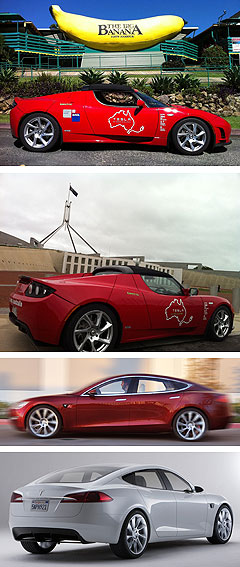Tesla EV charges from Melbourne to Port Douglas
BY HAITHAM RAZAGUI | 9th May 2011

GoAuto has calculated that, at the current petrol price of around $1.45 per litre, an internal combustion-powered car would need to consume less than 2.4 litres per 100km to achieve the same fuel cost over that distance.
The man behind the wheel was Tesla Motors Australia national sales and marketing manager Jay McCormack, who told GoAuto the brand has received 45 pre-orders (among a worldwide order bank exceeding 4000) for the Model S sports sedan that is due to launch here in the first half of 2013.
The Roadster Sport used by Mr McCormack for the journey is the most powerful variant of the Tesla sportscar – of which half a dozen examples have been sold in Australia since January – and at $260,535 is twice the expected cost of the Model S sedan.
The Roadster Sport features forged alloy wheels and its 215kW/400Nm electric motor provides an extra 30Nm over the standard Roadster 2.5 model – resulting in a 0-100km/h time of 3.7 seconds and a top speed of 212km/h.

The tour started from central Melbourne and followed main roads to Sydney via Canberra before tracking the east coast all the way up to Port Douglas in far north Queensland.
Tesla claims the Roadster – which shares its chassis, dashboard, fabric hard-top and windscreen with the Lotus Elise and represents the first all-electric production car to go on sale in Australia – is capable of covering 394km on a single charge of its 56kWh lithium-ion battery pack.
The Roadster exceeded its claimed 394km range throughout the run and Mr McCormack said that on long legs he was driving carefully to glean the greatest range possible from the battery.
“The main towns I was aiming for were between 350 and 400 kilometres apart, which meant we could really demonstrate the range the Roadster has,” he said.
“Of course, when you are driving for range and being strategic in the way you drive, the application of 400 kilometres is going to be possible.”Mr McCormack explained that changes in elevation were a significant factor in the Roadster’s energy consumption.
“Probably the highest elevation change was the 350 kilometres between Albury and Canberra, with an elevation change from about 168 metres to 680 metres, so a climb of about 500 metres.
“I achieved the 350 kilometres with 48 kilometres remaining on the battery pack, so still within the 400 kilometre realm.”The highest energy efficiency recorded on the tour was 127Wh/km, meaning the 65km from Cairns to Port Douglas was achieved using what Tesla claims is less energy than it takes to boil a kettle.
In total, power sufficient to propel the Roadster for roughly 700km of the trip was harvested through regenerative braking – effectively free energy.
“You do exploit the regenerative braking at every set of lights, making sure that you can coast as far as you can,” said Mr McCormack.
Around 80 per cent of the battery recharges on the trip were achieved at overnight stops with the use of standard 10-amp power outlets, which take 15 hours for a full charge. Some of the larger accommodation providers had access to three-phase power outlets, from which the Roadster could draw up to 32 amps for a faster recharge time of around 6.5 hours.
When the tour arrived in Brisbane, it took an unexpected detour to Tasmania, where Tesla was invited to become the first electric-powered competitor in the Targa Tasmania road race from 5 to 10 April, establishing a new EV Challenge class and taking advantage of renewable energy produced by Tasmania’s hydro-electric mains power.
In addition to the Roadster Sport driven by McCormack, a standard Roadster driven by Tesla’s chief technician for the Asia Pacific region, Rudi Tuisk entered the event, although some of the Targa stages were too long for the Tesla to complete on a single charge under race conditions.
During the trip there were no technical issues with the car and Mr McCormack said he found the accommodation providers along the way to be helpful and understanding in providing charging facilities.